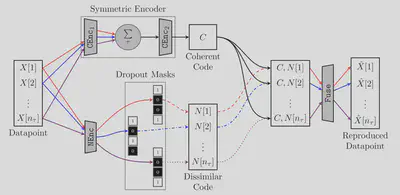
We proposed unsupervised deep-learning architecture called symmetric autoencoder (SymAE) to achieve redatuming. The key idea is that SymAE learns to represent the measurements using a latent code, in which the coherent and the nuisance information are disentangled. This unsupervised disentanglement is possible due to the following characteristics of SymAE’s architecture.
- Physical symmetry is explicitly embedded into the encoder so that certain dimensions of the latent code are invariant to the ordering of instances. This encoder prevents the communication of the instance-specific nuisance variations, thereby purely encoding the coherent information.
- The remaining latent-code dimensions are orthogonalized by stochastic regularization such that they fail to represent coherent information. Therefore, these latent components correspond only to the nuisance variations.
The structuring mentioned above means that the redatuming is equivalent to swapping the coherent codes in the latent space before decoding into a virtual instance. SymAE’s redatuming preserves and captures the salient features of the underlying physical modeling operator, thus enabling the use of virtual datapoints for subsequent downstream tasks such as parameter estimation.